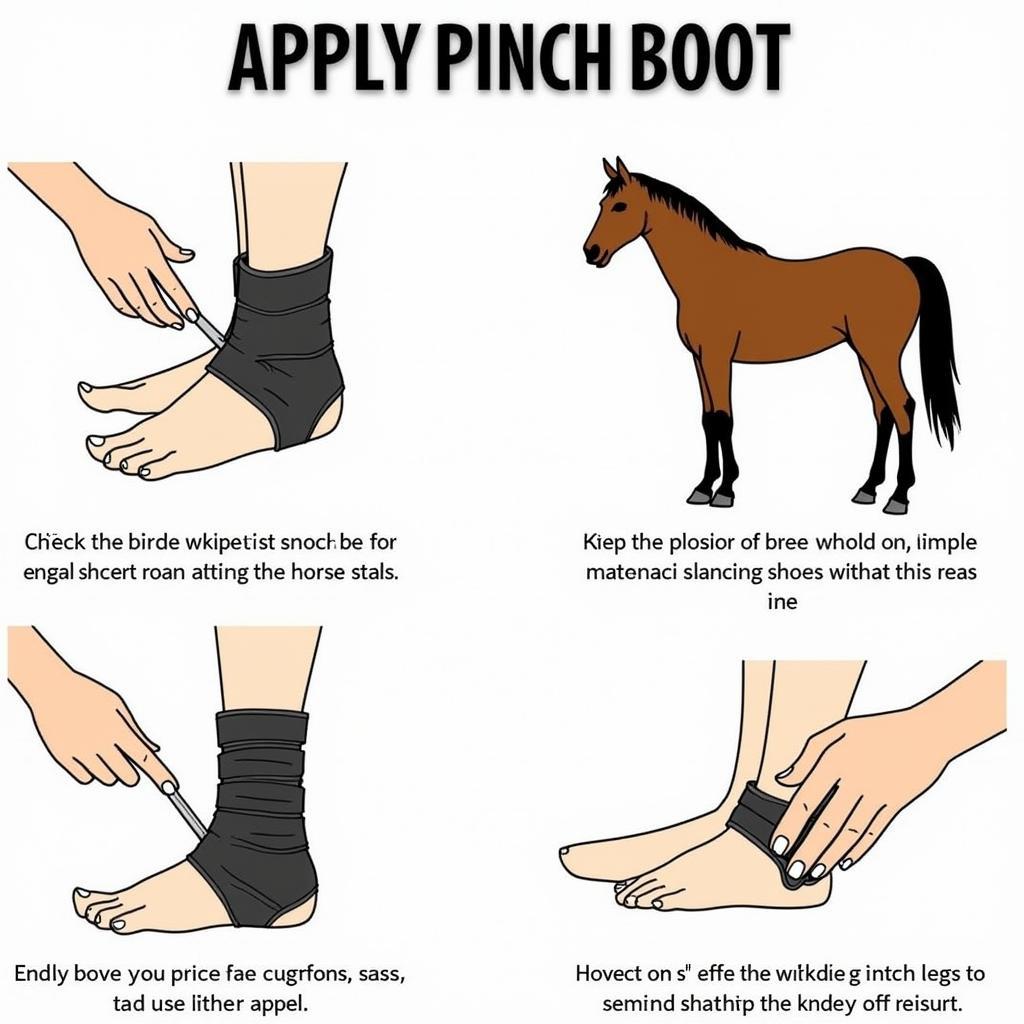Pinch Boots For Horses are a crucial piece of equipment for any horse owner concerned about lower leg injuries. These specialized boots provide support and protection, minimizing the risk of interference injuries, particularly in the fetlock and pastern areas. Whether you’re a seasoned equestrian or a beginner, understanding the benefits and proper usage of pinch boots is essential for maintaining your horse’s leg health and performance.
What Are Pinch Boots for Horses and Why Do You Need Them?
Pinch boots, also known as brushing boots or overreach boots, are designed to shield the horse’s lower legs from strikes and injuries caused by the hind hooves hitting the front legs. This “interference,” as it’s commonly called, can range from a slight brush to a severe overreach, leading to cuts, bruises, and even more serious injuries. Pinch boots act as a protective barrier, absorbing the impact and preventing damage. They are particularly useful for horses prone to interference due to conformation, gait, or shoeing. Do you want to learn more about other protective horse gear? Check out our page on horse hock ice boots.
Horses with a base-narrow stance, where the legs are closer together than ideal, are more susceptible to interference. Similarly, certain gaits like pacing or forging (where the hind hoof strikes the front hoof) increase the risk. Correct shoeing is vital, but even with proper farrier work, some horses may still benefit from the added protection of pinch boots. These boots are essential for maintaining your horse’s comfort and preventing costly vet bills due to leg injuries.
Choosing the Right Pinch Boots: A Comprehensive Guide
Selecting the right pinch boots is critical for ensuring effectiveness and comfort. Several factors should be considered, including size, material, and design. Proper fit is paramount; a boot that is too tight can restrict movement and cause discomfort, while a loose boot can slip and fail to provide adequate protection. Measure your horse’s pastern circumference carefully and consult the manufacturer’s sizing chart for guidance. Find great deals on cheap horse riding wear.
Materials range from durable synthetics like neoprene and PVC to natural materials like leather. Neoprene boots are lightweight, easy to clean, and offer good protection, while leather boots provide a more traditional look and excellent durability. Consider the type of riding you do and the environment in which you ride. For instance, neoprene boots are suitable for everyday riding and wet conditions, while leather boots might be preferable for competition or drier climates. Do you need full leg coverage? Our page on full leg ice boots for horses has more information.
“A proper fitting pinch boot is essential,” states Dr. Emily Carter, DVM, an equine veterinarian with over 20 years of experience. “It should snugly fit the pastern without being restrictive, allowing for full range of motion while providing adequate protection.”
How to Use Pinch Boots Correctly
Proper application and maintenance are crucial for maximizing the effectiveness of pinch boots for horses. Ensure the boots are clean and free of debris before applying them. Position the boot over the fetlock and pastern, ensuring it sits snugly without being too tight. Fasten the straps securely, checking that they are evenly tightened and not pinching the skin. After each use, clean the boots thoroughly and allow them to dry completely before storing them.
Regular inspection is important to identify any signs of wear and tear. Replace worn-out boots promptly to maintain optimal protection. Remember, a well-maintained boot is a safe and effective boot. Looking for additional horse riding apparel? Check out our horse t selection.
 Applying Pinch Boots Correctly
Applying Pinch Boots Correctly
“Regular maintenance of pinch boots is key to their longevity and effectiveness,” advises John Miller, a professional farrier with over 30 years of experience. “Cleaning and inspecting the boots regularly will help prevent premature wear and ensure they continue to provide adequate protection for your horse.”
Conclusion
Pinch boots for horses are an invaluable investment for protecting your horse’s lower legs from interference injuries. Choosing the correct type and ensuring proper fit and maintenance are crucial for maximizing their effectiveness. By incorporating pinch boots into your horse’s care routine, you can significantly reduce the risk of injury and promote long-term leg health. Learn more about pinch boots on our dedicated page: pinch boots horses.
FAQ
- How often should I use pinch boots on my horse?
- Can pinch boots be used on horses of all ages?
- What are the signs that a pinch boot doesn’t fit properly?
- Are there specific disciplines where pinch boots are more commonly used?
- How do I clean and maintain pinch boots?
- What are the alternatives to pinch boots for preventing interference injuries?
- Can pinch boots be used in conjunction with other protective legwear?
Need help? Contact us at: Phone Number: 0772127271, Email: [email protected] Or visit us at: QGM2+WX2, Vị Trung, Vị Thuỷ, Hậu Giang, Việt Nam. We have a 24/7 customer support team.